crane systems
What requirements must be considered when planning a crane system?
At the beginning of every planning there is first of all the definition of the requirements for the crane system, for example, performance requirements, output figures, but also, of course, the type of goods that are to be transported with the crane systems.
The next step is to determine a crane system with regard to the structural conditions and the requirements. This can be, for example, a portal crane, a bridge crane or a semi-portal crane system. But the decisive criterion is the transported goods themselves and thus also the selection of the suitable load handling device. This is where we decide, based on the complexity, whether we should design and plan individual load handling devices or whether we can make use of our modular system. These considerations or evaluations then decide which components are particularly important for a crane system. Depending on the requirements profile, i.e. throughput figures, automatic crane or semi-automatic crane or also in which overall system the crane system is used, various components such as drive systems or safety systems may then come to the fore.
What points do we clarify at the beginning of the planning phase?
At the beginning, it is important that we determine in detail the installation site or the general conditions where the crane will be used. Here, the climate, the pollution and the areas of application play an important role. The specific application is of great importance, what does the transported material look like, weight, storage capacity, lifting distances, installation situation in the hall, are there interfaces to other lot, machines? These are very important points we look at in detail.
Span, speed and trolley decisive
For this purpose, it is important to know the exact loads, driving cycles, cycle times, and classifications and then to design them correctly accordingly.. For the design of the crane, the span and the speed as well as the design of the trolley are decisive criteria. Also the requirements for the electrical design as well as requirements from our customers. In the case of automatic crane systems, it is important at the beginning of the planning phase to jointly define the work safety and the safety concept, as this is where access and concepts are defined as to how these automatic areas can later be accessed for maintenance.
What needs to be considered in the specific design of the subsequent crane construction?
High loads combined with high speeds. These are the key challenges for the design of the crane construction and its drives. Special features in the control and regulation technology are required in order to be able to feed and discharge the materials, which weigh several tons, precisely and often with millimeter accuracy.
A detailed analysis of the requirements and the preparation of a requirement specification help to evaluate the economic efficiency of investment costs and the correct dimensioning of the crane design.
Analysis of requirements
Further, the cost-effectiveness of the investment costs combined with the robust design of all components plays an important consideration. Topics such as energy efficiency are becoming increasingly important and must be constantly analyzed. However, the most important thing at the beginning of a crane design is the analysis of the requirements, which are usually compiled in a specification sheet. If this is not the case, we will be happy to advise and support you.
Savings potential through correct dimensioning
From our experience, however, we like to mention that we are often faced with requirements that later turn out not to be necessary, resulting in the crane being equipped with disproportionately expensive or even oversized drives. This is where we see great potential at the beginning of a crane design.
What makes a crane a special crane?
A special crane becomes a special crane primarily through its load equipment. At Vollert, we always tailor these exactly to the customer's requirements or to the workpieces to be transported. A load handling device can be, for example, a coil tong for gripping aluminum or steel coils, a hydraulic gripper for ingots, a gripper for wire coils or any long material. In paint shops, product carriers equipped with rollers are even used as load handling devices to move components attached to them through the following pretreatment and coating systems. More common, however, are automatic coil and ingot storage systems in the aluminum and steel industries, which are then equipped with appropriate grippers.
Mechanically driven coil tongs were implemented in the fully automatic coil storage system at Zhongwang Aluminium in China. The tongs are characterized by an extremely high range of adjustment. In addition, the direction in which the coil is deposited can be changed by 90 degrees to the right or to the left via a built-in slewing gear.
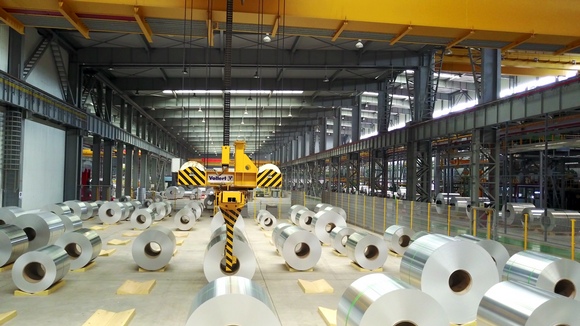
Best Case: Bridge Crane System with Mechanical Coil Tongs
Another example is a hydraulic ingot gripper that has been integrated into an automatic crane system. This means different requirements than with a manual crane system. Here, above all, the speeds are much higher, in this project example 3.7 m per second. In addition, gripping of the ingot also takes place in an automatic mode. Tis means: Detection of the ingot, safe gripping, and above all safe gripping even in the event of malfunctions, such as a power failure. If so, it must be ensured that the ingot is still held securely in the gripper for a certain time.
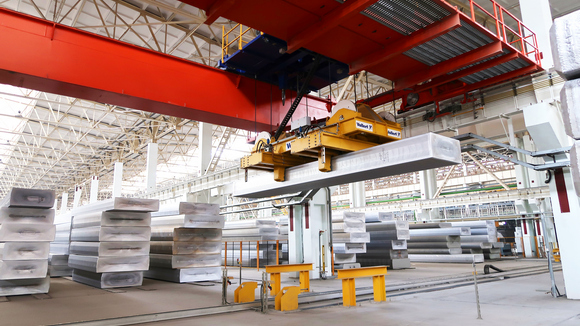
Best Case: Bridge Crane System with Hydraulic Ingot Gripper
Next, here you can see an electric ingot gripper. The difference is that the ingot is gripped after the machining process and must not be damaged anymore on its surface. That is why the gripper tongs are equipped with special supports and the ingot is gripped from below . The wide variance of the ingots in widths from 700 mm up to two meters requires that the gripper tongs have a wide range of adjustment.. Since the tongs are also used in an automatic crane system, various sensor and weighing measurements ensure that we can safely detect and also safely transport any ingot, regardless of its width.
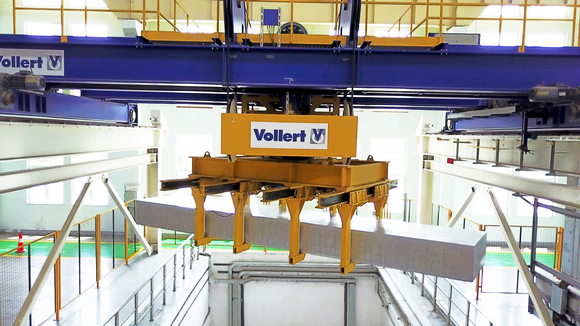
Best Case: Bridge Crane System with Electric Ingot Gripper
Which crane type offers which advantages?
During the clarification of the framework conditions, the question is also raised as to which crane system can be used. Basically, we distinguish here between the portal crane, the semi-portal crane and the bridge crane.
Portal crane - ideal for goods handling yards or in outdoor storage facilities
The special feature of a portal crane is that it does not require a typical crane steel structure or building supports where the crane runways are installed or deposited. The portal crane therefore travels independently on two rails laid in the ground and is therefore often used in goods handling areas or in open-air warehouses, i.e. anywhere where steel structures would interfere. However, we have already used this principle at Giga Coating in a dip-painting plant. Here, a 55-meter portal crane feeds the workpieces weighing up to nine tons to the twelve dip tanks in a predefined sequence. The workpieces are lowered by two individually synchronized hoists. This ensures optimum immersion of the workpieces in the dip tanks.
Portal crane at Giga Coating
Semi-portal crane - application as loading/unloading crane
Semi-portal cranes are often used as loading/unloading cranes, for example in paint shops. This design is ideal if one side of the crane can be connected to an existing steel structure serving as the guide side. The ground-moving side then runs on a rail laid in the ground, as in the case of a portal crane, thus ensuring free access to the loading/unloading point. The aforementioned steel structure, onto which the guided or high side is connected, in most cases then houses the process technology towards which the workpieces are to be fed.
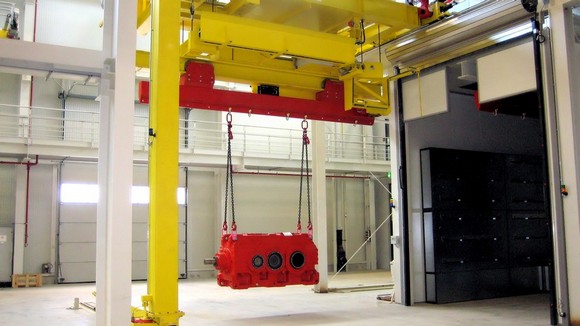
Semi-portal crane at SEW Eurodrive
Bridge crane - the crane system for high plant availability
Contrary to a portal or semi-portal crane, the bridge crane requires in any case a building structure or a steel structure on which both rails can be placed on top.
Typically, a bridge girder crane consists of either one or two box girders, which is then additionally operated by a trolley with a winch or other hoist.. In most cases, these special cranes operate round the clock, often in automatic mode. High demands are also placed on these cranes in terms of plant availability.
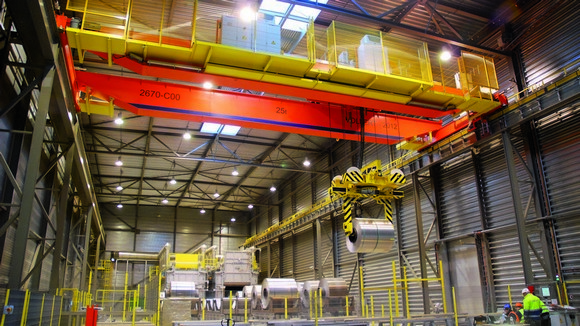
Double girder bridge crane at Aleris
What smart features do modern crane systems from Vollert offer?
Modern crane systems are subject to ever-increasing demands in terms of productivity, efficiency and safety. Here, Vollert relies on special smart features, such as the pendulum control, which controls the travel mouvement of the bridge and trolley. Many smart features also play an important role in lifecycle planning.

